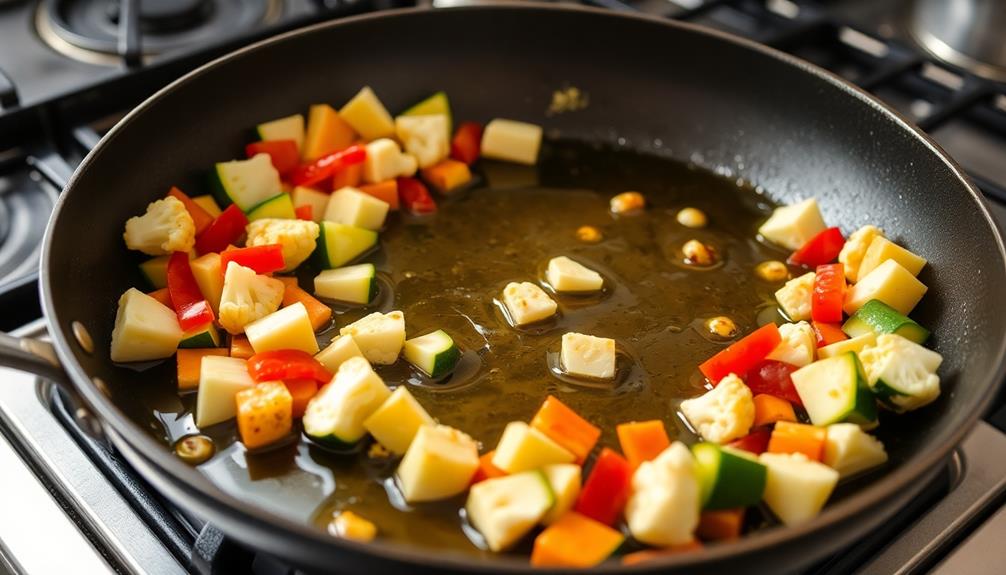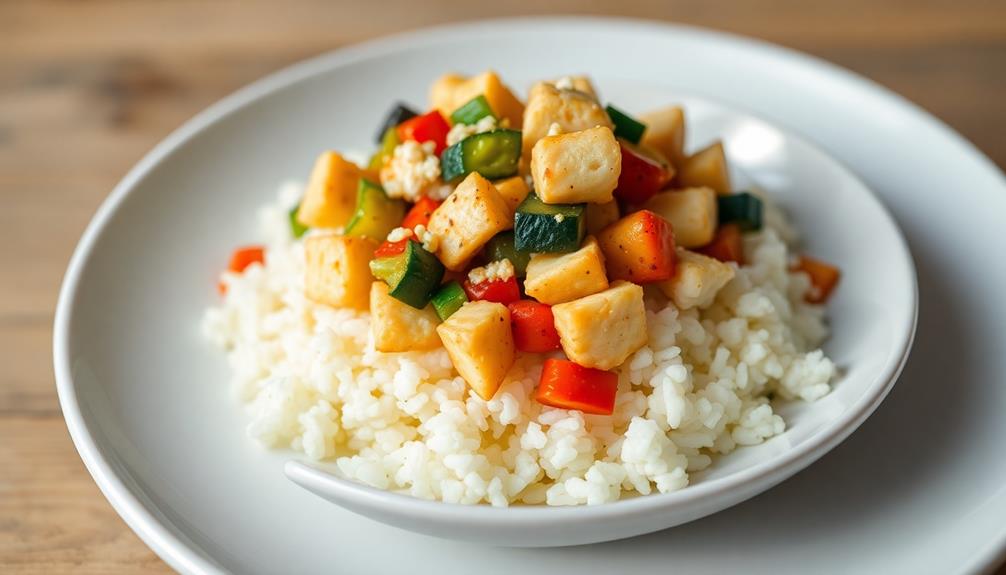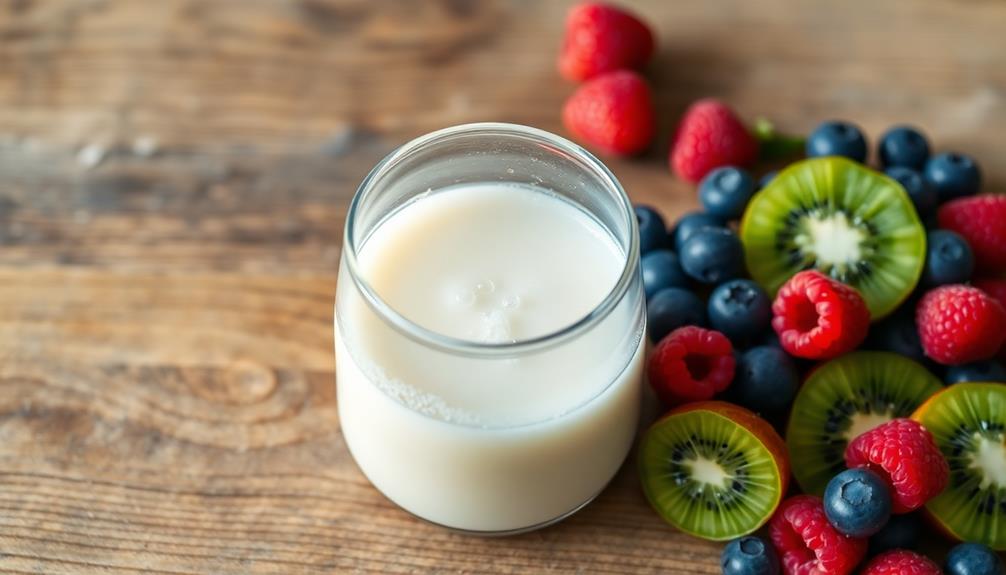As a vegetarian seeking the benefits of a ketogenic diet, you'll find a wealth of plant-based, high-fat options to fuel your journey. Creamy avocados, nutty seeds, and versatile tofu and tempeh provide essential nutrients and protein, while coconut products, olive oil, and healthy fats like those found in chia seeds offer the caloric density you need. Pair these with low-carb veggies like cauliflower and zucchini, and you've got a balanced, nutrient-dense plate that supports your health goals. Discover more delectable vegetarian keto recipes and insights to make the most of this sustainable way of eating.
Key Takeaways
- Focus on high-fat plant-based sources like avocados, nuts, seeds, and coconut products to meet the macronutrient requirements of the ketogenic diet.
- Incorporate tofu and tempeh as primary protein sources, providing essential nutrients while keeping carbohydrates low.
- Use low-carb vegetables like cauliflower and zucchini to increase fiber intake and maintain ketosis.
- Enhance flavor and nutrition with chia seeds, garlic powder, and herbs, without adding significant carbohydrates.
- Prepare vegetarian keto dishes by sautéing vegetables in healthy oils, adding protein, and serving over cauliflower rice for a balanced, nutrient-dense meal.
History
Although the ketogenic diet has been around for nearly a century, its application to vegetarian diets is a more recent development. The ketogenic diet, which emphasizes high-fat, low-carb consumption, was initially used in the 1920s to treat epilepsy. Over time, it gained popularity as a weight-loss strategy, but vegetarians often struggled to adapt the diet to their plant-based lifestyles.
With the rising interest in weight loss, many have turned to ingredients like chia seeds, known for their benefits of chia seeds for weight loss, to enhance their keto meals.
In the past decade, however, more and more vegetarians have embraced the keto approach. By focusing on high-fat plant foods like avocados, nuts, and coconut oil, they've discovered how to achieve ketosis – the metabolic state where the body burns fat for fuel – without relying on animal products.
This has opened up new possibilities for vegetarians seeking the potential benefits of keto, from weight management to improved energy levels. As awareness of keto-friendly vegetarian options grows, the combination of these two dietary approaches continues to evolve, offering a unique perspective on healthy, sustainable eating.
Recipe
Eating a vegetarian diet and following a keto lifestyle may seem like an impossible combination, but with the right recipes, it can be done. This keto-friendly vegetarian dish isn't only delicious but also packed with nutrients to keep you feeling satisfied and energized.
The key to this recipe is the use of plant-based proteins, healthy fats, and low-carb vegetables. By carefully selecting the right ingredients, you can create a meal that's both ketogenic and vegetarian-friendly.
- 1 cup diced cauliflower
- 1/2 cup diced zucchini
- 1/4 cup diced red bell pepper
- 2 ounces crumbled tofu
- 2 tablespoons olive oil
- 1 teaspoon garlic powder
- 1 teaspoon onion powder
- 1/2 teaspoon salt
- 1/4 teaspoon black pepper
In a large skillet, heat the olive oil over medium heat. Add the cauliflower, zucchini, and bell pepper, and sauté for 5-7 minutes, or until the vegetables are tender.
Stir in the crumbled tofu, garlic powder, onion powder, salt, and black pepper, and continue cooking for an additional 2-3 minutes, or until the tofu is heated through.
When preparing this dish, be mindful of the cooking time for the vegetables. You want them to be tender but not overcooked, as this can affect the texture and flavor.
Additionally, feel free to experiment with different spice blends or add-ins, such as roasted nuts or seeds, to enhance the taste and nutritional profile of the meal.
Cooking Steps
Sauté your veggies in olive oil to start.
Next, add a blend of spices and herbs to infuse your dish with flavor.
Then, toss in some tofu or tempeh and let the mixture simmer for 10-15 minutes.
Step 1. Sauté Vegetables in Olive Oil

First, heat a large skillet or sauté pan over medium-high heat. Once it's nice and hot, drizzle in a tablespoon or two of extra virgin olive oil.
Carefully add your chopped veggies – let's say, some colorful bell peppers, zucchini, and onions. Incorporate low-carb vegetables to boost your fiber intake while sautéing. Sauté them, stirring frequently, until they start to soften and brown around the edges, about 5-7 minutes.
Now, season with a pinch of salt and pepper. You can also throw in some dried herbs like oregano or basil to ramp up the flavor. Sauté for another 2-3 minutes, until the veggies are tender but still have a bit of a bite.
Be careful not to overcook them – you want them to retain their vibrant colors and crunch.
When they're done, remove the skillet from the heat. Your perfectly sautéed veggies are now ready to be enjoyed as a delicious side dish or incorporated into your favorite keto-friendly meal.
Step 2. Add Spices and Herbs

With your sautéed veggies ready, now's the time to add some spices and herbs to enhance their flavor. A sprinkle of garlic powder, onion powder, or dried oregano can instantly boost the savory notes.
For a punch of freshness, try chopping up some basil, cilantro, or parsley and stirring it in at the end. Additionally, consider incorporating chia seeds into your meals for their nutritional benefits, such as their high fiber content and ability to support digestive health.
Don't be afraid to get creative – experiment with curry powder, cumin, or paprika for a more robust flavor profile. The key is to start with small amounts and taste as you go. You can always add more, but it's harder to tone down an overpowering spice blend.
Pay attention to how the flavors meld and adjust accordingly. Letting the spices and herbs mingle with the sautéed veggies for a minute or two before serving will allow the aromas to bloom.
With a little seasoning know-how, you can transform simple sautéed veggies into a flavor-packed, keto-friendly side dish.
Step 3. Add Tofu or Tempeh

To further enhance your keto-friendly vegetarian meal, you can incorporate tofu or tempeh. These soy-based foods are versatile, high in protein, and low in carbs – perfect for a keto diet.
Tofu is a soft, custardy block made from pressed and coagulated soy milk. It's a great source of plant-based protein and can be used in a variety of dishes, from stir-fries to desserts.
Tempeh, on the other hand, is a firmer, more textured soy product made by fermenting cooked soybeans. It's packed with probiotics and has a slightly nutty flavor.
When cooking with tofu or tempeh, be sure to press out any excess moisture first to help it brown and crisp up. You can then marinate or season it with your favorite keto-friendly herbs and spices before sautéing, baking, or grilling it.
Incorporating these soy-based proteins into your vegetarian keto meals can add flavor, texture, and essential nutrients to your diet.
Step 4. Simmer Mixture for 10-15 Minutes

Once the ingredients are combined, simmer the mixture for 10-15 minutes. This step allows the flavors to meld and the tofu or tempeh to soak up all those delicious seasonings.
Keep the heat at a medium setting, so the mixture doesn't boil over. Stir it occasionally to prevent sticking or burning. You'll know it's ready when the liquid has reduced and the tofu or tempeh has a tender, slightly chewy texture.
Don't be tempted to crank up the heat to speed things up – that can make the outside get crispy while the inside stays undercooked. Take your time and let the flavors develop slowly. This gentle simmering is key to creating a rich, satisfying keto-friendly dish.
Once the 10-15 minutes are up, give the mixture a final stir and remove it from the heat. Now you're ready to serve or use this flavorful base in other recipes. Enjoy your hard work!
Step 5. Serve Over Cauliflower Rice

Now that your simmered tofu or tempeh has developed a rich, satisfying flavor, it's time to serve it over a bed of cauliflower rice. Cauliflower rice is a fantastic low-carb alternative to traditional rice, and it pairs beautifully with the bold, savory flavors of your keto-friendly protein.
To prepare the cauliflower rice, simply pulse fresh or frozen cauliflower florets in a food processor until they resemble the size and texture of rice grains. You can also grate the cauliflower using a box grater.
Once you've got your riced cauliflower, transfer it to a skillet and sauté it over medium heat until it's tender and lightly browned, about 5-7 minutes. Season it with a pinch of salt and pepper to taste.
Spoon the simmered tofu or tempeh over the warm cauliflower rice and enjoy this delicious, nutrient-dense vegetarian keto meal. The combination of the savory protein and the fluffy, mild-tasting cauliflower rice creates a perfectly balanced and satisfying dish. For additional flavor and nutrients, consider adding a side of sautéed spinach or roasted broccoli to complement the main dish. These ketofriendly vegetable dishes will add a pop of color and a dose of vitamins to your meal while keeping it low-carb. Experiment with different vegetable combinations to create a variety of delicious and satisfying keto-friendly meals.
Final Thoughts
The keto diet can be an effective way for vegetarians to achieve their health and weight goals. With a bit of planning and creativity, you can enjoy a variety of delicious, nutrient-dense plant-based keto meals.
Remember, the key is to focus on high-fat foods like avocados, nuts, seeds, and coconut products, while limiting carbohydrates from fruits, vegetables, and grains.
As you continue your keto journey, don't be afraid to experiment with new recipes and ingredients. Be patient with yourself, and don't get discouraged if the process takes time. Sugar substitutes on keto can be a great alternative to satisfy any sweet cravings you may have. There are various options such as stevia, erythritol, and monk fruit that can be used in place of regular sugar in your recipes. Just be mindful of how these substitutes may affect your body and adjust as necessary. Remember, it’s all about finding what works best for you and your keto lifestyle. Navigating natural sweeteners on keto can be a game-changer for your diet. Using ingredients like coconut sugar, maple syrup, or honey may seem counterintuitive, but in moderation, they can still be incorporated into your keto lifestyle. Remember, it’s important to read labels and understand the impact of these natural sweeteners on your body. Finding the right balance of sweeteners and experimenting with different recipes will help you stay on track with your keto goals.
Celebrate your small wins, and remember that the long-term benefits of the keto lifestyle are worth the effort. With dedication and a positive mindset, you can reach your goals and feel your best on a vegetarian keto diet.
Embrace the journey, and enjoy the delicious and satisfying meals along the way.
Frequently Asked Questions
How Can I Ensure I Get Enough Protein on a Keto Vegetarian Diet?
To ensure you get enough protein on a keto vegetarian diet, focus on high-protein plant-based foods like tofu, tempeh, legumes, nuts, and seeds. Pair these with healthy fats to meet your keto macros and keep your protein intake sufficient.
What Are the Best Sources of Healthy Fats for a Keto Vegetarian?
The best sources of healthy fats for a keto vegetarian diet are avocados, nuts, seeds, olive oil, coconut oil, and full-fat dairy products like cheese, Greek yogurt, and heavy cream.
Can I Still Consume Soy Products on a Keto Vegetarian Diet?
Yes, you can still consume soy products on a keto vegetarian diet. Tofu, tempeh, and soy milk are all good sources of protein and healthy fats that can fit into a low-carb lifestyle.
How Can I Overcome the Challenge of Limited Food Options on Keto?
To overcome the limited food options on keto, you can explore a variety of plant-based, high-fat foods like avocados, nuts, seeds, coconut products, and olive oil. Get creative with recipes to make the most of your choices.
What Are the Potential Side Effects of a Keto Vegetarian Diet?
Potential side effects of a keto vegetarian diet include nutrient deficiencies, constipation, and fatigue. You'll need to carefully plan your meals to ensure you're getting enough protein, fiber, and essential vitamins and minerals.









